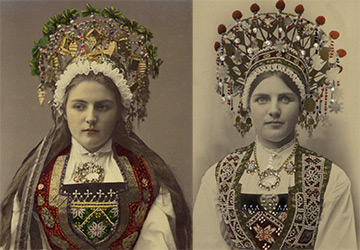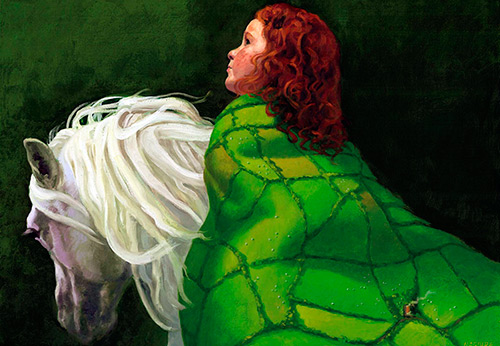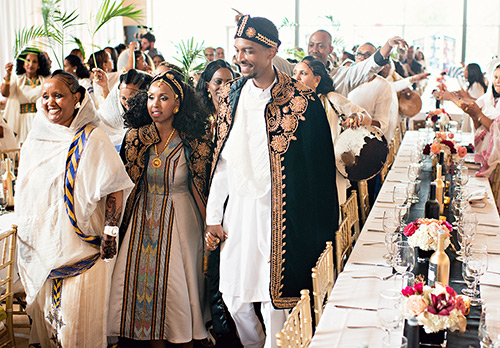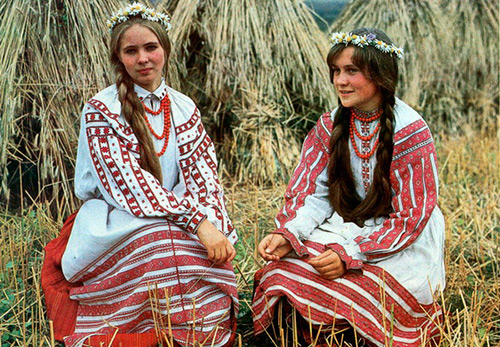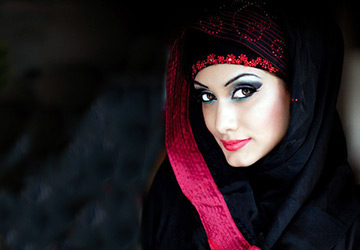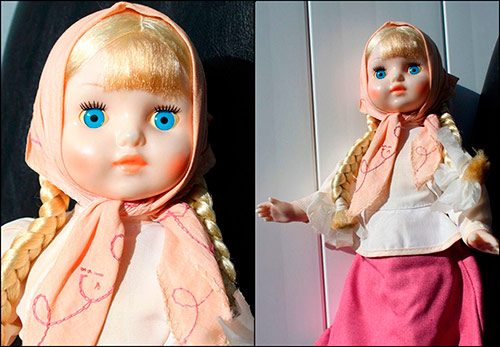Style
Traditional costume and fashion of the countries of the Arab East
The costume of the countries of the East is diverse, as are the traditions of the numerous peoples inhabiting the vastness of Asia. However, there are many common features in the costume of these peoples, associated, among other things, with a common history for them, and with a common religion - Islam.
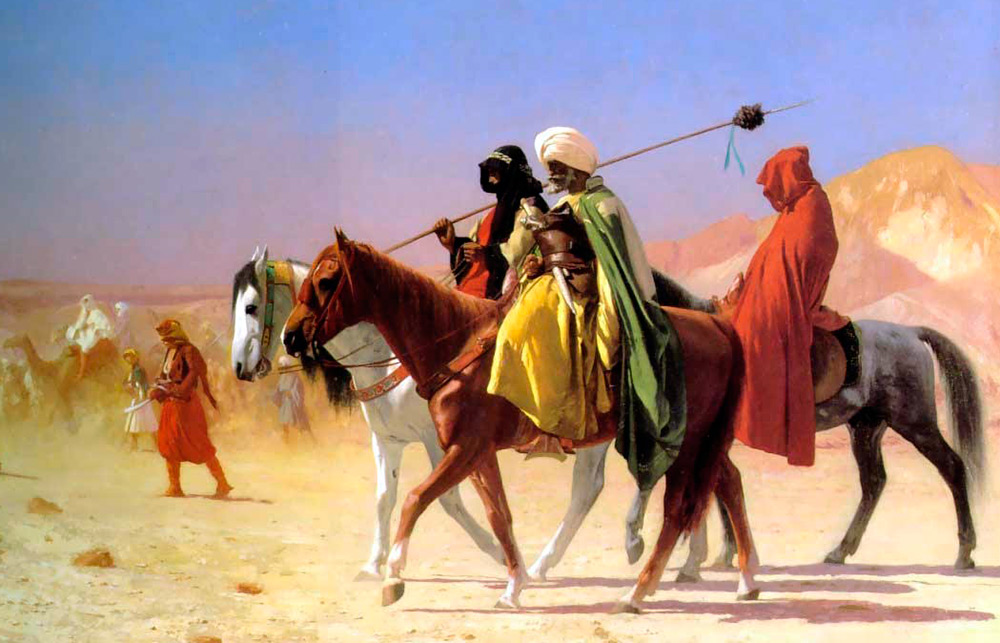
Jean-Leon Gerome (1824-1904)
Arabs crossing the desert
Influence of the Arab Caliphate on fashion
The traditional costume of the Arab countries was formed during the time of the Arab Caliphate, namely in the 7th-8th centuries. This time is considered the heyday of the Caliphate, the borders of which at that time began in the valley of the Indus River and ended at the shores of the Atlantic Ocean.
The Arab Caliphate lasted until the 13th century, but at the same time left a significant cultural heritage and influenced the development of the peoples of all territories that were part of it. And these are the territories of such modern countries as Syria, Palestine, Egypt, Sudan, Tunisia, Morocco, Spain, India, Turkey and, of course, the territory of the Arabian Peninsula, where the history of the Caliphate began.
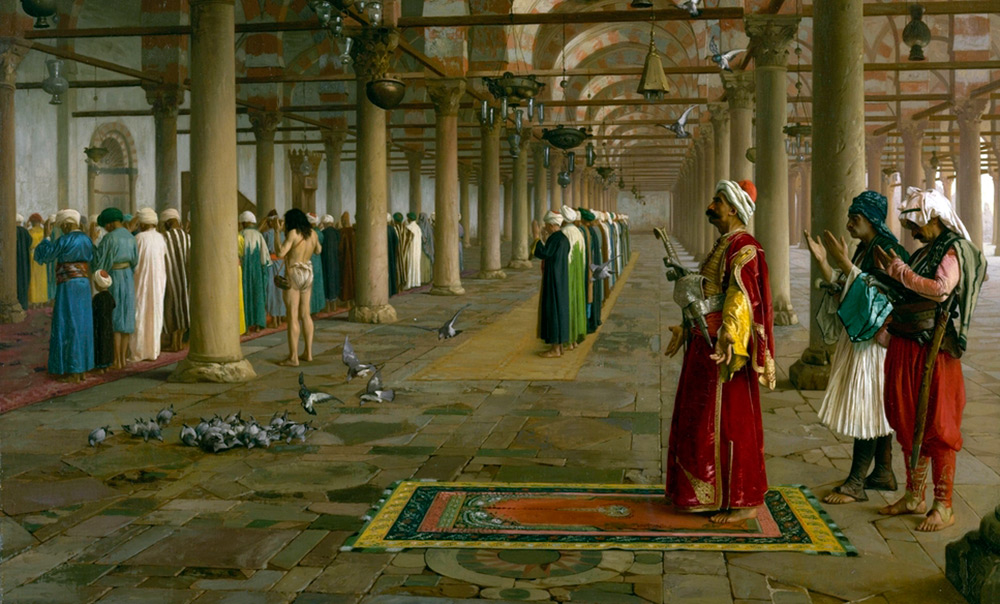
Jean-Leon Gerome (1824-1904)
Prayer in the mosque
In Islam, it is forbidden to depict a person, therefore, information about the traditional Arab costume can be gleaned in literature, in the images of the inhabitants of the Muslim East, created by Europeans, as well as thanks to the traditional clothing that the peoples of the East wear to this day.
One of such sources on the history of the Arabian costume can be the fairy tales "A Thousand and One Nights". So, Scheherazade was described as the owner of a graceful camp, a white smooth face (it was "like the moon on the fourteenth night"), almond-shaped dark eyes under thick and long black eyebrows. It is believed that this was the ideal of female beauty during the Arab Caliphate.
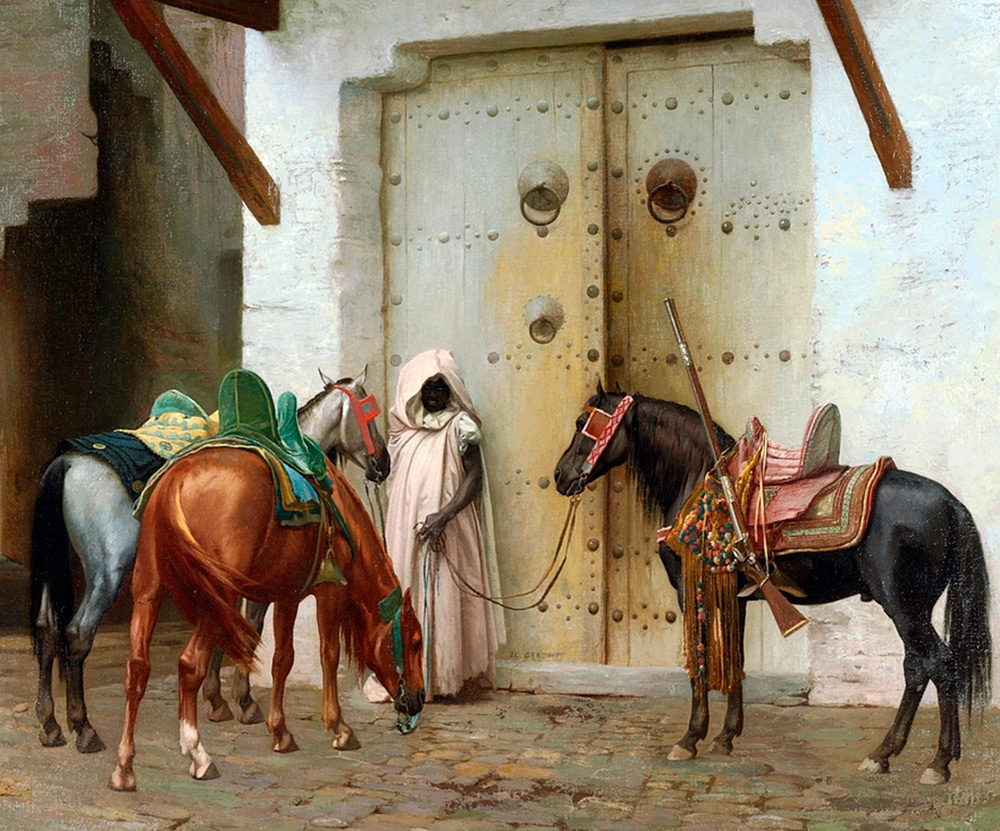
Jean-Leon Gerome (1824-1904)
Stop
As for the costume, representatives of all classes of society (from the peasant to the caliph) wore the same clothes in their style, which differed only in the quality of the fabric and the richness of the decor.
Men's suit and the fashion of the Arab East
In ancient times, the men's clothing of the Arabian tribes consisted of a wide and long shirt, with or without sleeves. And also a cover that protected the head of the nomads from the scorching rays of the sun. It was the long shirt and the veil that formed the basis of the traditional Arab costume.
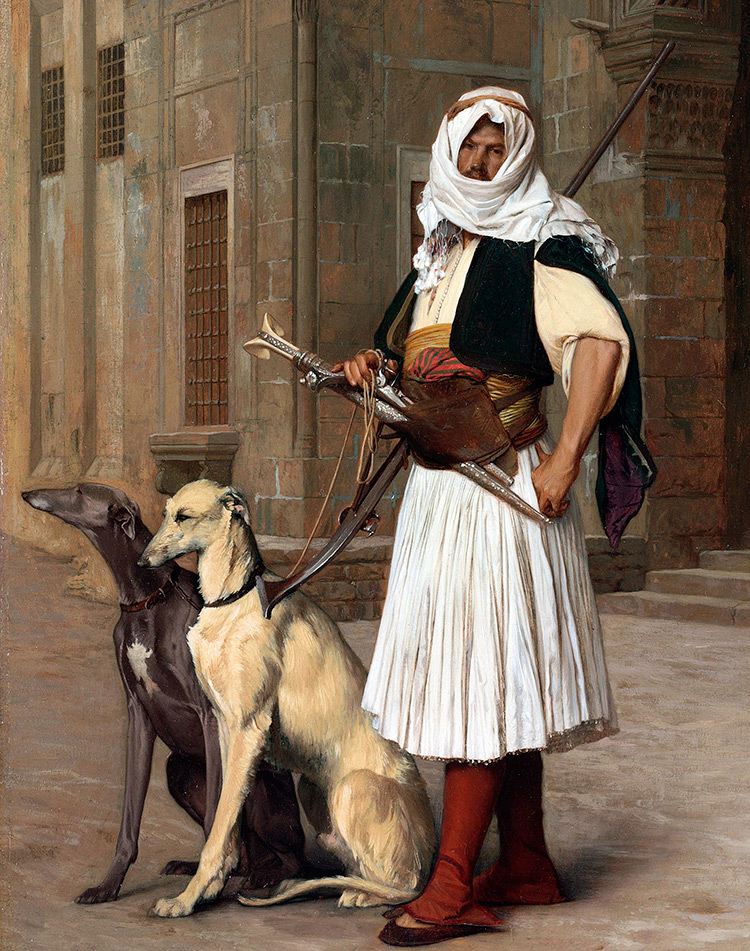
Jean-Leon Gerome (1824-1904)
Arab with two dogs
Such a shirt consisted of two sewn panels and was necessarily girded with a belt. On top of the shirt, an abbas cloak was worn - a cloak made of sheep or camel wool. The coverlet was made of a quadrangular piece of fabric and was attached to the head with a braid.
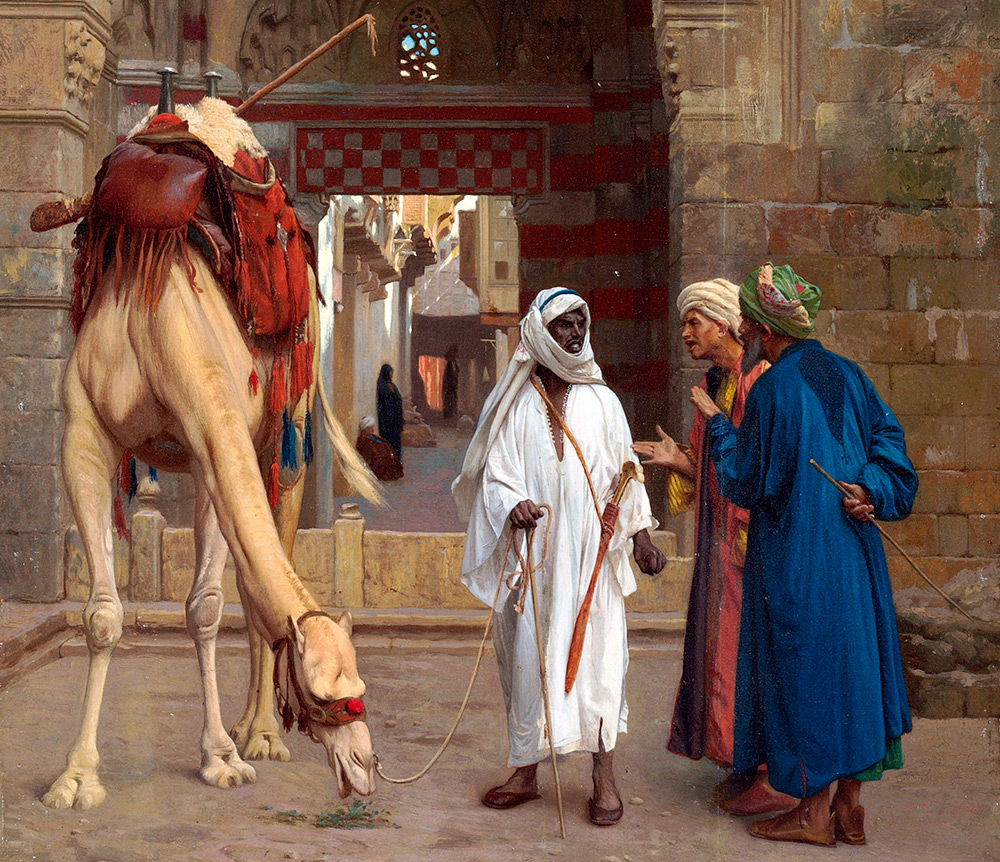
Jean-Leon Gerome (1824-1904)
Arab dispute
During the period of wars and the expansion of the territories of the Caliphate, innovations appear in clothing, often borrowed from the conquered peoples. So, pants were borrowed from the nomadic peoples of Asia, which became an indispensable element of the Arab costume. Harem pants were white, sewn from cotton fabrics and ankle-length. At the waist, such pants were attached with a drawstring.
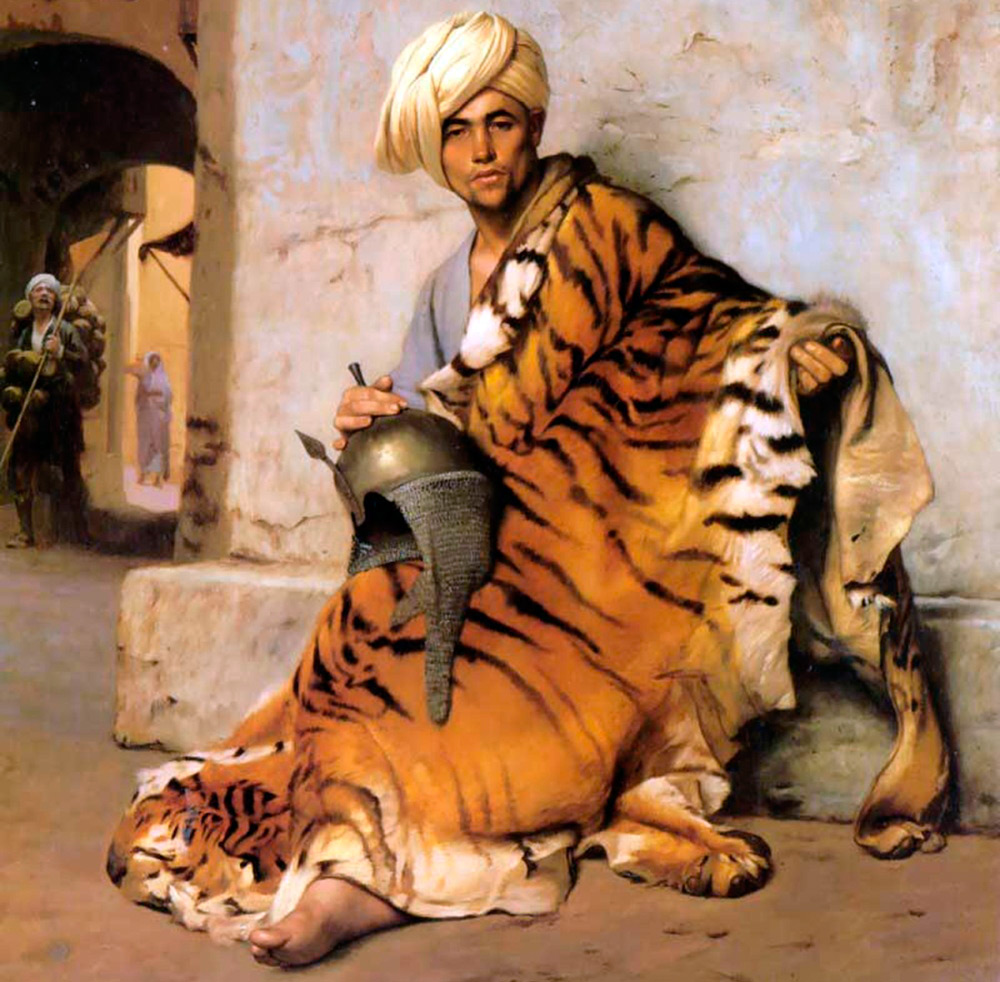
Jean-Leon Gerome (1824-1904)
Fur trader in Cairo
Soon, over a white undershirt, men begin to wear a robe (or haftan) - clothes with long sleeves decorated in the forearm with inserts of contrasting fabric with inscriptions or patterns. Such a caftan robe was necessarily belted. The first such clothing, most likely, appeared in the days of Persia. Fashion in the Middle Ages wearing caftans will come to Europe precisely from the countries of the Arab East.
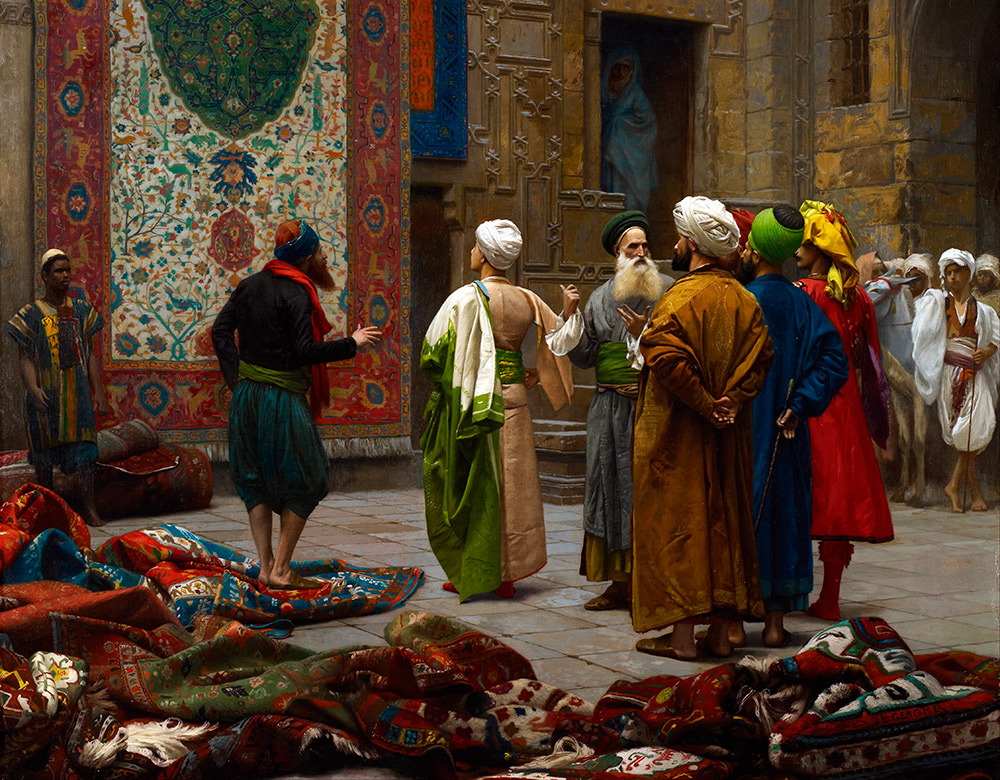
Jean-Leon Gerome (1824-1904)
Carpet merchant
Also, in the cold season, men could wear woolen clothes such as a caftan with a lining - such clothes were called jubba.When it was cold, a wool cloak was also worn, which was called aba, abai or abaya. Such a cloak could be worn by both men and women.
A turban served as a man's headdress. And also keffiyeh - a veil or a man's headscarf.
Women's clothing of the Arab East
The traditional women's costume of the countries of the Arab East was very similar to the men's costume. The main feature of the female, as well as the male, suit of Muslim countries was the simplicity and freedom of clothing, as well as the closeness of the whole body.
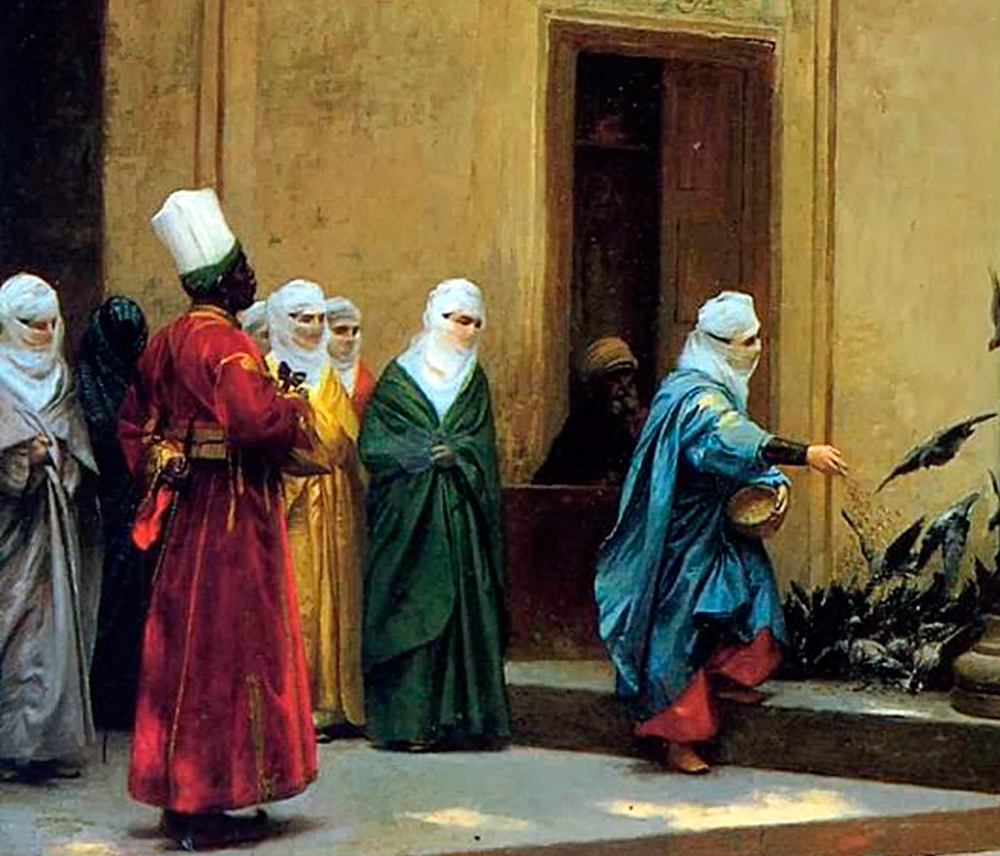
Jean-Leon Gerome (1824-1904)
Harem girls feed pigeons
Women also wore undershirts, caftans and harem pants called shalwar. These pants were pulled at the hips and gathered in many folds.
Women could wear dresses as well. For example, in the Emirates, women wore a gandur dress - a traditional dress decorated with embroidery from gold or colored and silver threads. With such a dress, they also wore trousers, which were called shirval - trousers with pleats. Another traditional women's dress is abaya. Abaya is a long dress made of dark or black fabric. Women of the East wear ghandur and abaya dresses to this day.
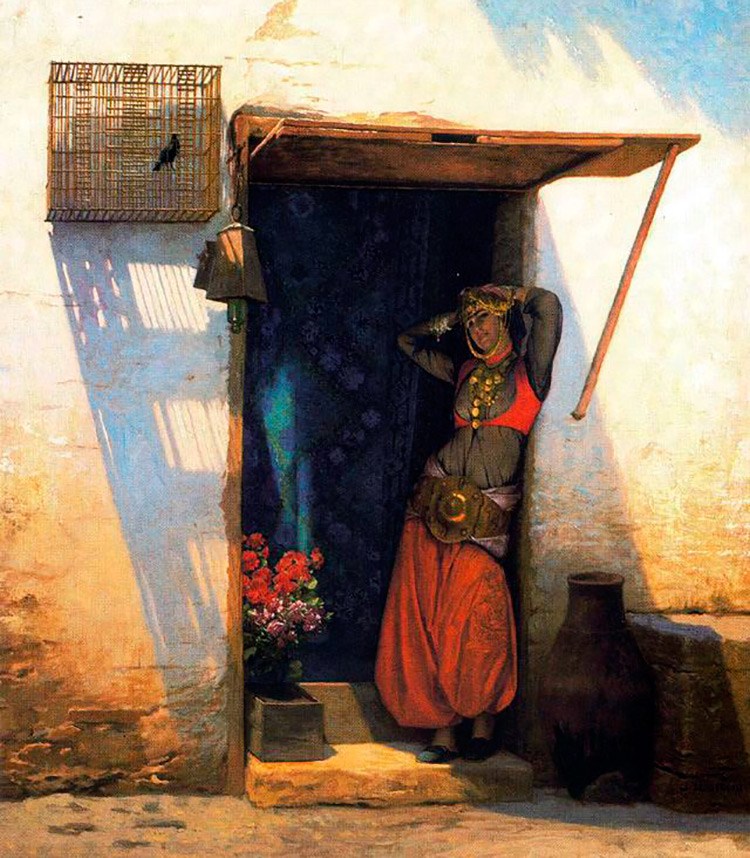
Jean-Leon Gerome (1824-1904)
Plot 3
Since ancient times, women in Arab countries have worn veils on their heads. So, during the times of the Arab Caliphate, going out into the street, women covered their faces with an izar. Izar is a blanket, the upper end of which was pulled over the back of the head and fastened with a cord on the forehead, while the rest of the fabric in the front was fastened with a clasp or held by hands and fell over the back and sides, almost completely covering the figure.
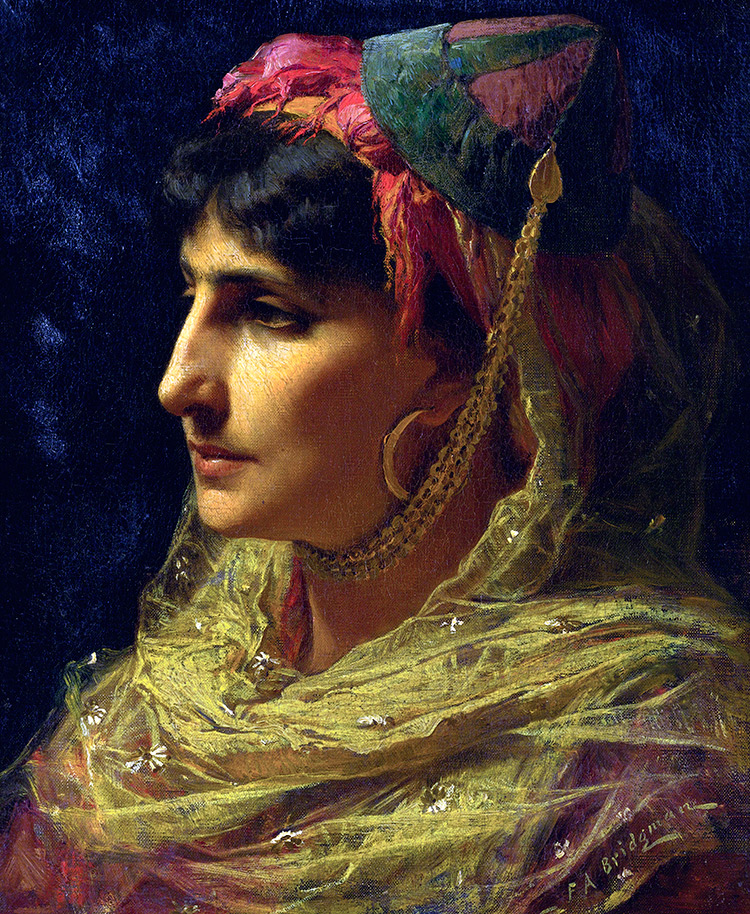
Frederick Arthur Bridgeman (1847-1928)
At the same time, in different parts of the former Arab Caliphate, the women's veil will eventually acquire local characteristics and different names. So, in the countries of the Middle East, the veil will begin to be called the burqa, most likely from the Persian word ferenje, which means "hole", "window leaf". Such a veil completely covered the figure and only for the face was left a kind of "window" - a window in the form of a thick mesh fabric.
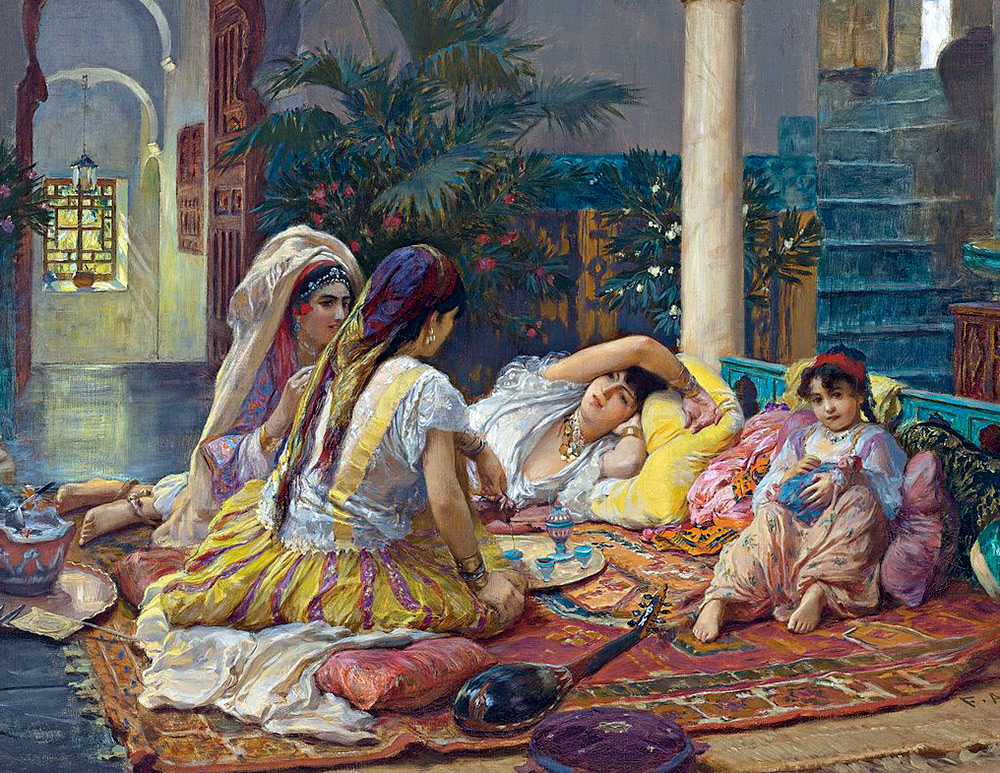
Frederick Arthur Bridgeman (1847-1928)
In the harem
In the Arab countries (countries of the Arabian Peninsula), the veil is still most often called hijab... Translated from Arabic, this word means a veil. By hijab, most often they mean a scarf that covers the head and neck, while the face remains open. Together with the hijab, women of the East can also wear the niqab - it covers the face, leaving only the eyes open.
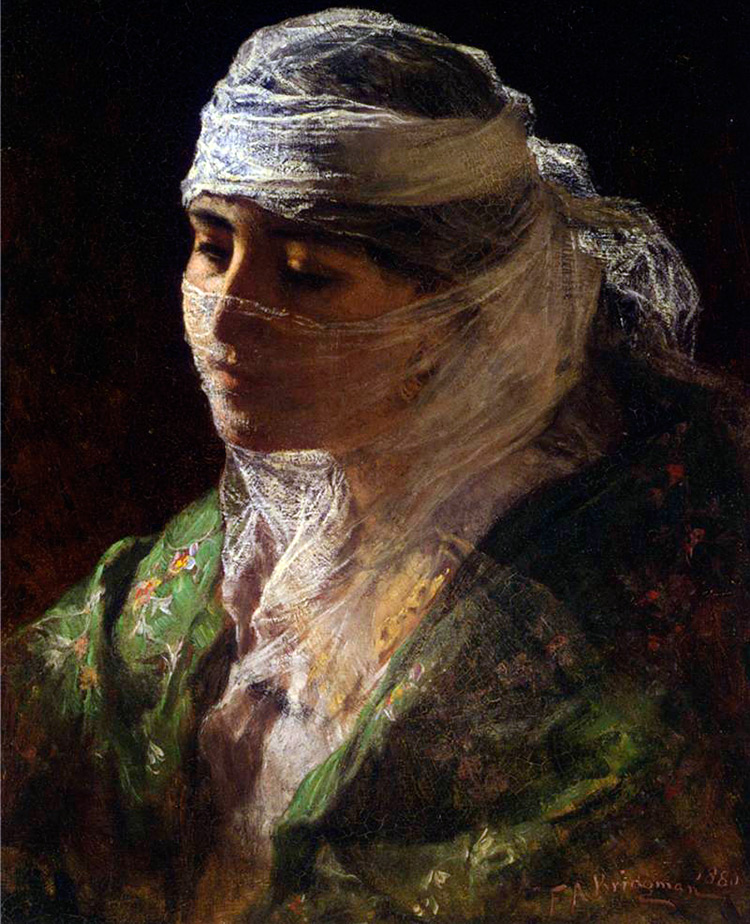
Frederick Arthur Bridgeman (1847-1928)
Also in Muslim countries, women can wear a veil such as a chador. The veil completely covers the woman from head to toe, but the face may remain open in some cases. The word veil itself, as well as the veil, is of Persian origin. And translated from Persian it means tent.
Influence of Persia on Islamic fashion
Persia, like the Arab Caliphate, had a great influence on the formation of the traditional costume of the countries of the Muslim East.
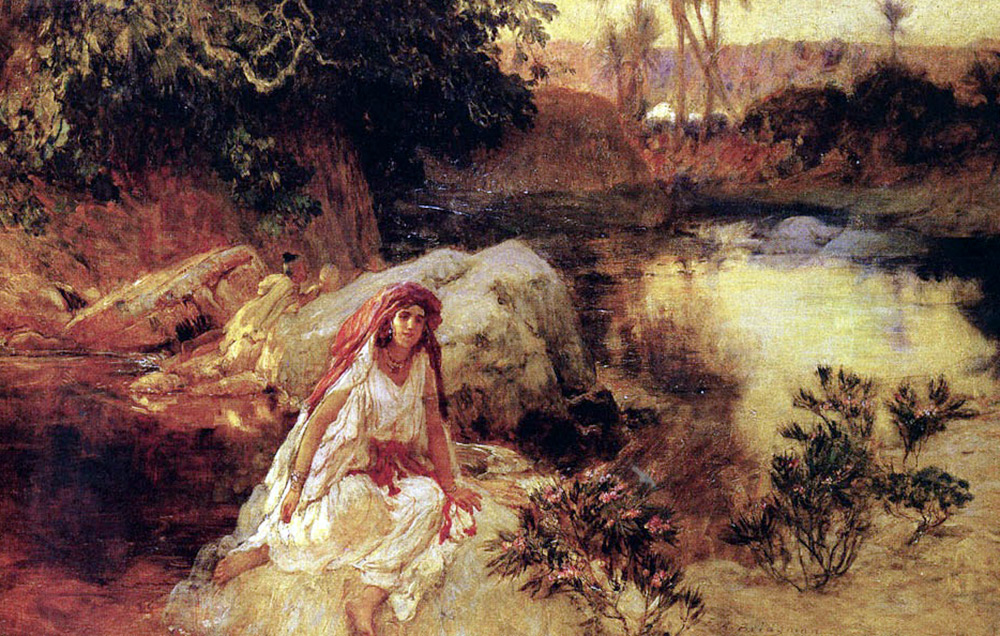
Frederick Arthur Bridgeman (1847-1928)
Oasis
It was from Persia that the Arabs borrowed such elements of clothing as the veil, burqa, turban, and caftan.
The Persian kingdom existed from the 6th to the 4th centuries BC on the territory of modern Iran.
The Persian male costume consisted of leather pants and a leather caftan with a belt. The caftan and trousers could also be made of wool. At the same time, when the Persian king Cyrus conquered Media, he introduced the fashion among his courtiers to wear Median clothing, which also influenced the formation of the Arab costume. Median clothing was made of silk or fine wool, dyed purple and red. It was long and consisted of pants, a caftan-robe and a cape.
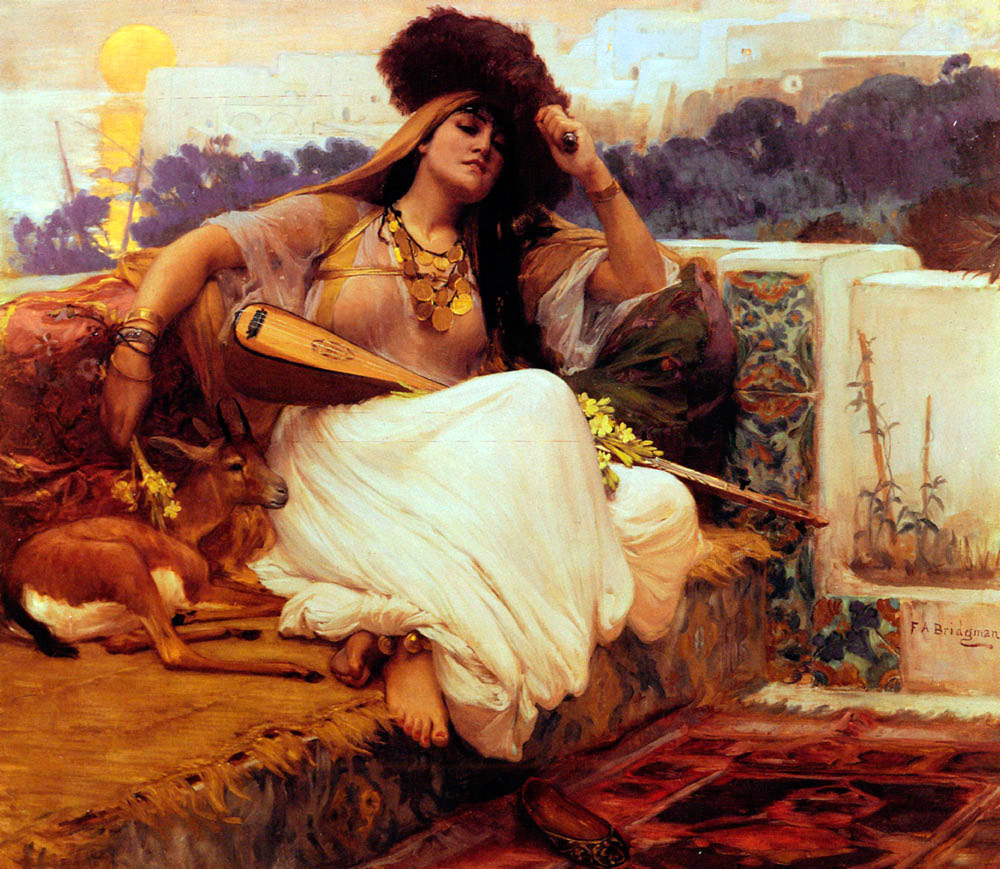
Frederick Arthur Bridgeman (1847-1928)
Almost nothing is known about the female costume of Persia, since only male images have survived on the ancient Persian bas-reliefs that have survived to this day - images of hunters and warriors. However, Persians were painted by the ancient Greeks. For example, on their vases.So, it can be assumed that in Persia women wore clothes made of expensive fabrics, long and wide, somewhat reminiscent of a man's suit. But at the same time, they were distinguished by the richness of the decor.
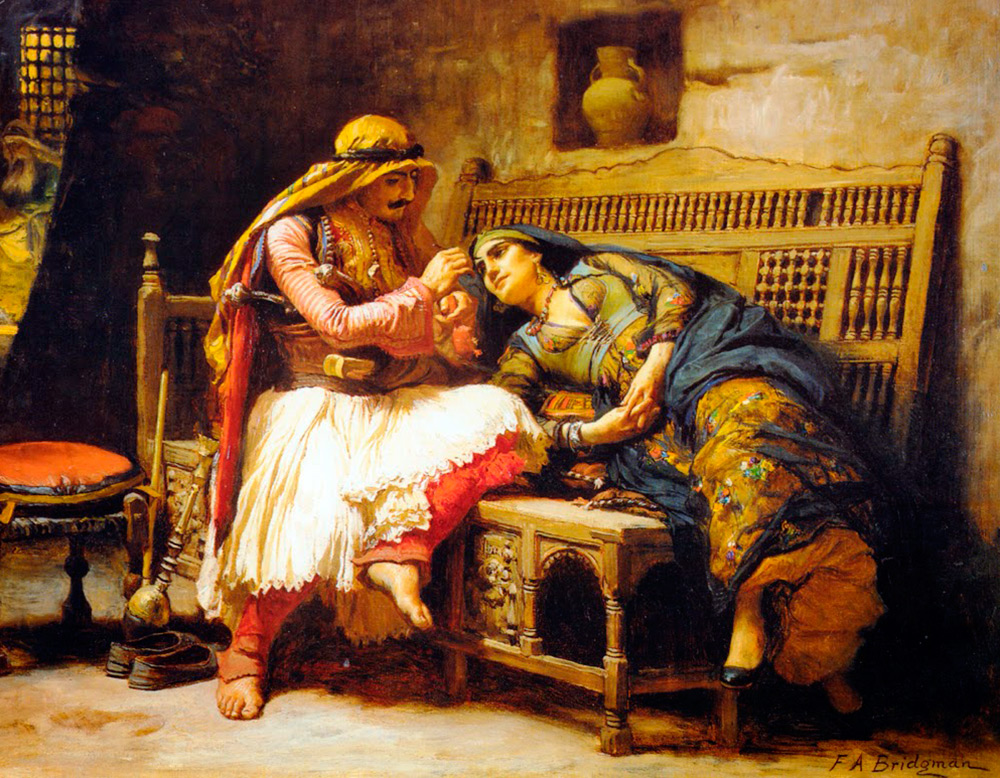
Frederick Arthur Bridgeman (1847-1928)
Rogue Queen
Various bedspreads served as a female headdress. While men wore felt caps and leather hats.
Thus, the traditional costume of the countries of the Arab East has absorbed the elements of clothing of many peoples - from the peoples of ancient Media and Persia to the peoples of the Arab Caliphate.
Comments and Reviews
Add a comment
Rating news
Shades of clothing that make women look younger
What shades of hair make women younger: rules and photos
Funny wedding dresses - photos and ideas
12 most expensive down jackets for the winter
How to look 25 at 40: tips from supermodels
Beautiful schoolgirls
Anti-aging haircuts and hairstyles for women
Fashionable skirts for autumn and winter
Fashionable women's trousers for the cold season
Fashionable and stylish sandals for summer 2024
Spring-summer 2024
 Fashionable dresses and tops with thin spaghetti straps
Fashionable dresses and tops with thin spaghetti straps
 Bandana tops: how to wear stylishly and beautifully
Bandana tops: how to wear stylishly and beautifully
 How to put together the perfect men's wardrobe for the summer
How to put together the perfect men's wardrobe for the summer
 Fashionable shorts for spring-summer 2024
Fashionable shorts for spring-summer 2024
 Fashionable skirts for spring-summer 2024: a guide to online shopping
Fashionable skirts for spring-summer 2024: a guide to online shopping
 The most fashionable dresses spring-summer 2024: styles and colors
The most fashionable dresses spring-summer 2024: styles and colors
 Fashionable total look 2024: ideas of images and trends
Fashionable total look 2024: ideas of images and trends
